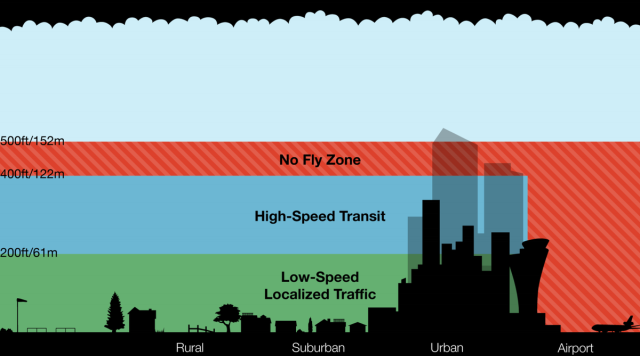 Yesterday at NASA’s UTM Convention, Amazon laid out its vision for a multi-tiered superhighway in the sky, one in which all drones flying above 200 feet would have the ability to communicate with — and ideally sense and avoid — other aircraft.
Yesterday at NASA’s UTM Convention, Amazon laid out its vision for a multi-tiered superhighway in the sky, one in which all drones flying above 200 feet would have the ability to communicate with — and ideally sense and avoid — other aircraft.
It’s an attempt to put an end to the Wild West atmosphere that has been the norm for uncrewed aerial systems (UAS) over the last five years, replacing it with a next-generation air traffic control system. It hopes to establish a basic regulatory framework and set of technical standards that manufacturers can work toward. All this would prepare the airspace for a time when thousands, even tens of thousands of drones fly over the average city delivering parcels, monitoring air quality, and handing out parking tickets.
Amazon’s proposal, which is in line with similar ideas floated by NASA and Google, would create a slow lane for local traffic below 200 feet and a fast lane for long-distance transport between 200 and 400 feet. Altitudes between 400 and 500 feet would become a no-fly zone, and anything above that is already against FAA regulations for hobbyists. While some commercial drone operators are pushing to fly large UAS above 500 feet, Amazon is avoiding that discussion for now.
Commercial aircraft are governed by FAA’s Air Traffic Control, and in Amazon’s vision, there would be a similar central command and control network that takes in data about the position of each drone and shares it with every other vehicle connected to the network. There would also be vehicle-to-vehicle communication, similar to what we are starting to see with autonomous automobiles. Access to the different layers of the airspace would be governed by how well your drone can communicate with its pilot, the command and control network, and other drones. “Everyone can have access to the airspace,” says Gur Kimchi, who heads up Amazon’s Prime Air program. “It doesn’t matter if you’re a hobbyist or a corporation. If you’ve got the right equipment, you can fly.”
If you’re operating a radio-controlled quadcopter with no internet connection, then you would be relegated to the area below 200 feet. That may rub some hobbyists the wrong way, but given that even cheap consumer drones are now connected to the internet through their apps, it seems unlikely that there will be too many UAS which fall into this category. And while complex sense and avoid (SAA) technology is not yet widespread among consumer drones, we are already seeing it appear on units like the Lily, in software from Skydio, and in developer hardware like DJI’s Matrice. If the pace of development in this area continues, sense and avoid technology will be standard on consumer drones within a few years.
/cdn0.vox-cdn.com/uploads/chorus_asset/file/3914118/Screen_Shot_2015-07-28_at_8.14.50_AM.0.png)
In traditional air traffic control, humans have handled much of the work. But with small UAS, the number of aircraft in the sky at any given time is likely to be many times greater than the number of commercial aircraft. So Amazon is proposing we let the machines handle more of the work themselves. “Right now the standard is an aircraft that can basically fly itself, with a human at the controls to take over at anytime,” says Kimchi. “But with UAS, there won’t be a single operator for every drone. We need a lot more automation than we have with the traditional model.”
Amazon says its drones would automatically adjust their path if they are on a collision course, and also warn one another about obstacles. “I am from Seattle, there are many seagulls,” Kimchi says. “Our drone would automatically get out of the way and also alert others in the area.”
/cdn0.vox-cdn.com/uploads/chorus_asset/file/3914174/Screen_Shot_2015-07-28_at_8.18.15_AM.0.png)
This new air traffic control system would also link UAS with traditional aircraft. If a helicopter from the fire department needed to fly low over an emergency, for example, it would be able to communicate with command and control, warning drones it was in the area, and creating a geofenced area around itself that would become a no-fly zone, as depicted in the graphic above.
It’s still unclear who exactly will take the lead in creating this new layer of transportation. The FAA seems to be giving NASA leeway to take the lead. NASA in turn seems eager to work with the private sector. It’s partnered with Verizon on a new program, with support from Google and Amazon, that would allow cell towers to serve as nodes in this system, helping to track drones and exchange critical information between aircraft and fleets. Clear regulations would have to emerge and manufactures would have to buy into the new standards. Kimchi believes this is the only way to create a robust drone economy: “Everybody who flies in the same complex airspace need to speak the same language.”
Amazon’s plan also tries to make room for hobbyists and researchers, by including airspace for open flying fields where anyone is welcome to operate, regardless of the kind of equipment they are carrying. This would be a safe space to fly at great heights and without meeting all the command and control requirements, as the airspace would be marked off and avoided by commercial flights. “We need a predefined low-risk area where people can experiment,” says Kimchi. “We don’t have any plans to fly at 12,000 feet, but if that is something you are interested in, go for it!”
Source: The Verge


“Altitudes between 400 and 500 feet would become a no-fly zone, and anything above that is already against FAA regulations for hobbyists”
No, it is against FAA guidelines. There is currently no rule that says you can’t fly a personal drone above 400 ft.